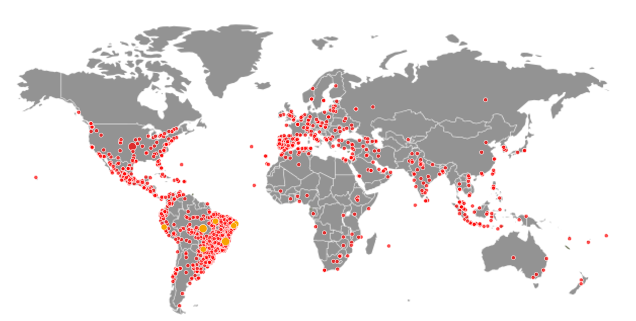SCIENCE COMMUNICATION IN THE CONTEXT OF ARBOVIRAL DISEASES: CONTRIBUTIONS TO HEALTH EDUCATION
DOI:
https://doi.org/10.61164/rsv.v6i1.3904Keywords:
social media, public health, pandemic, digital education, science communicationAbstract
The COVID-19 pandemic and the resulting mobility restrictions imposed by public agencies and international health organizations have intensified the use of digital tools to maintain dialogue between the academic-scientific community and the general public. Simultaneously, there was a significant increase in the spread of misinformation, especially on the internet, driven by the population's broad engagement with social media. In this context, this project, developed by graduates of the Biomedicine program at UNIRIO, aimed to disseminate information and promote dialogue about arboviruses through the social media platform Instagram, as well as to evaluate the effectiveness of this strategy. Image-based posts were published on the Mosquitando profile between April and May 2021. Subsequently, data on views and engagement were analyzed, along with the number and profile of followers in terms of geographic location, age group, and gender. The results indicated a higher participation of young individuals (18–24 years old), residing in the municipality of Rio de Janeiro (72.6%), and identifying as female (73.9%).
References
ADNEWS. Infográfico mostra perfil do usuário brasileiro no Instagram. 2016. Disponível em: https://adnews.com.br/infografico-mostra-perfil-do-usuario-brasileiro-no-instagram/. Acesso em: 4 abr. 2021.
BARRETO, O. S.; AMORIM, L.; GARCIA, M. P.; ALMEIDA, C. Zika e microcefalia no Facebook da Fiocruz: a busca pelo diálogo com a população e a ação contra os boatos sobre a epidemia. Revista Eletrônica de Comunicação, Informação e Inovação em Saúde, v. 14, n. 1, p. 18-33, 2020. DOI: https://doi.org/10.29397/reciis.v14i1.1792
BESERRA, E. B. et al. Ciclo de vida de Aedes (Stegomyia) aegypti (Diptera, Culicidae) em águas com diferentes características. Iheringia. Série Zoologia, v. 99, n. 3, 2009. DOI: https://doi.org/10.1590/S0073-47212009000300008
BRASIL. Ministério da Saúde. Secretaria de Vigilância em Saúde. Boletim Epidemiológico – Monitoramento dos casos de arboviroses urbanas transmitidas pelo Aedes aegypti (dengue, chikungunya e zika). Semanas Epidemiológicas 1 a 53. Brasília, DF, 2021.
BRASIL. Ministério da Saúde. Secretaria de Vigilância em Saúde. Boletim Epidemiológico – Síndrome congênita associada à infecção pelo vírus Zika. Brasília, DF, 2019.
BRISOLA, M. C.; ALENCAR, J. Revisión de los mosquitos del género Haemagogus Williston (Diptera: Culicidae) de Brasil. Revista Biomed, v. 21, n. 3, p. 221-238, 2010.
CANVA. Canva: plataforma de design gráfico. 2021. Disponível em: https://www.canva.com/. Acesso em: 25 setembro. 2021.
CHEN, R. et al. ICTV virus taxonomy profile: Togaviridae. Journal of General Virology, v. 99, n. 6, p. 761–762, 2018. DOI: https://doi.org/10.1099/jgv.0.001072
COSTA, F. V. Uso do Instagram como ferramenta de estudo: análise de um perfil da área biológica. Research, Society and Development, v. 8, n. 10, 2019. DOI: https://doi.org/10.33448/rsd-v8i10.1360
D’ANGELO, P. Pesquisa Instagram no Brasil 2021: dados dos usuários brasileiros. 2021. Disponível em: https://blog.opinionbox.com/pesquisa-instagram/ Acesso em: 4 abr. 2021.
DANTAS, L. F. S.; DECCACHE-MAIA, E. Scientific Dissemination in the fight against Fake News in the Covid-19 times. Research, Society and Development, 2020, 9(7). DOI: https://doi.org/10.33448/rsd-v9i7.4776
DE OLIVEIRA FIGUEIREDO, P.; STOFFELLA-DUTRA, A. G.; BARBOSA COSTA, G.; SILVA DE OLIVEIRA, J.; DOURADO AMARAL, C.; DUARTE SANTOS, J.; SOARES ROCHA, K. L.; ARAÚJO JÚNIOR, J. P.; LACERDA NOGUEIRA, M.; ZAZÁ BORGES, M. A.; PEREIRA PAGLIA, A.; DESIREE LABEAUD, A.; SANTOS ABRAHÃO, J.; GEESSIEN KROON, E.; BRETAS DE OLIVEIRA, D.; PAIVA DRUMOND, B.; DE SOUZA TRINDADE, G. Re-Emergence of Yellow Fever in Brazil during 2016–2019: Challenges, Lessons Learned, and Perspectives. Viruses, 2020, 12(11):1233. DOI: https://doi.org/10.3390/v12111233
DONALISIO, M. R.; FREITAS ARR, A.; ZUBEN, A. P. B. V. Arboviruses emerging in Brazil: challenges for clinic and implications for public health. Revista de Saúde Pública, 2017, 51(30). DOI: https://doi.org/10.1590/s1518-8787.2017051006889
FERRARIS, P.; YSSEL, H.; MISSÉ, D. Zika virus infection: an update. Microbes and Infection, 2019, 21(8–9):353–60. DOI: https://doi.org/10.1016/j.micinf.2019.04.005
FIGUEIREDO, L. T. M. The Brazilian flaviviruses. Microbes and Infection, 2000, 2(13):1643–49. DOI: https://doi.org/10.1016/S1286-4579(00)01320-4
GIOVANETTI, M.; MENDONÇA, M. C. L.; FONSECA, V.; MARES-GUIA, M. A.; FABRI, A.; XAVIER, J.; JESUS, J. G.; GRAF, T.; RODRIGUES, C. D. S.; SANTOS, C. C.; SAMPAIO, S. A.; CHALHOUB, F. L. L.; NOGUEIRA, F. B.; THEZE, J.; ROMANO, A. P. M.; RAMOS, D. G.; ABREU, A. L.; OLIVEIRA, W. K.; SAID, R. F. C.; ALBUQUERQUE, C. F. C.; OLIVEIRA, T.; FERNANDES, C. A.; AGUIAR, S. F.; CHIEPPE, A.; SEQUEIRA, P. C.; FARIA, N. R.; CUNHA, R. V.; ALCANTARA, L. C. J.; FILIPPIS, A. M. B. Yellow Fever Virus Reemergence and Spread in Southeast Brazil, 2016–2019. Journal of Virology, 2019, 94(1). DOI: https://doi.org/10.1128/JVI.02008-19
KENDALL, C.; KHALID, H.; MULLER, M.; BANDA, D. H.; KOHL, A.; MERITS, A.; SONHOU-SE, N. J.; TUPLIN, A. Structural and phenotypic analysis of Chikungunya virus RNA replication elements. Nucleic Acids Research, 2019, 47(17):9296–312. DOI: https://doi.org/10.1093/nar/gkz640
KUHN, R. J.; ZHANG, W.; ROSSMAN, M. G.; PLETNEV, S. V.; CORVER, J.; LENCHES, E.; JONES, C. T.; MUKHOPADHYAY, S.; CHIPMAN, P. R.; STRAUSS, E. G.; BAKER, T. S.; STRAUSS, J. H. Structure of Dengue Virus: Implications for Flavivirus Organization, Maturation, and Fusion. Cell, 2002, 108(5):717–25. DOI: https://doi.org/10.1016/S0092-8674(02)00660-8
LIMA-CAMARA, T. N. Arboviroses emergentes e novos desafios para a saúde pública no Brasil. Revista de Saúde Pública, 2016, 50:36. DOI: https://doi.org/10.1590/S1518-8787.2016050006791
LOPES, N.; NOZAWA, C.; LINHARES, R. E. C. Características gerais e epidemiologia dos arbovírus emergentes no Brasil. Revista Panamazônica de Saúde, 2014, 5(3):55-64. DOI: https://doi.org/10.5123/S2176-62232014000300007
LOWE, R.; BARCELLOS, C.; BRASIL, P.; CRUZ, O. G.; HONÓRIO, N. A.; KUPER, H.; CARVALHO, M. S. The Zika Virus Epidemic in Brazil: From Discovery to Future Implications. International Journal of Environmental Research and Public Health, 2018, 15(1):96. DOI: https://doi.org/10.3390/ijerph15010096
MINAYO, M. C. S.; GOMES, R. Divulgação Científica: a última e imprescindível etapa do processo científico. Ciência & Saúde Coletiva, 2012, 17(1):4-5. DOI: https://doi.org/10.1590/S1413-81232012000100001
MONATH, T. P.; VASCONCELOS, P. F. C. Yellow fever. Journal of Clinical Virology, 2015, 64:160–73. DOI: https://doi.org/10.1016/j.jcv.2014.08.030
NEVES, D. P.; VITOR, R. W. A.; LINARDI, P. M.; MELO, A. L. Parasitologia Humana. 12ª ed. São Paulo: Atheneu, 2011.
PLOURDE, A. R.; BLOCH, E. M. A Literature Review of Zika Virus. Emerging Infectious Diseases, 2016, 22(7):1185-1192. DOI: https://doi.org/10.3201/eid2207.151990
PROENCA-MODENA, J. L.; MILANEZ, G. P.; COSTA, M. L.; JUDICE, C. C.; COSTA, F. T. M. Zika virus: lessons learned in Brazil. Microbes and Infection, 2018, 20(11–12):661–9. DOI: https://doi.org/10.1016/j.micinf.2018.02.008
RANGIWALA, S.; TOWBIN, A. J. Use of social media in radiology education. Journal of the American College of Radiology, 2018, 15(1):190-200. DOI: https://doi.org/10.1016/j.jacr.2017.09.010
RIBEIRO, R. C.; SCHNEIDER, C.; FREIRE, E. S.; VASCONCELOS, L. D. P.; SILVA, C. F.; FERREIRA, P. J. O. Postagens em rede social digital como meio de divulgação científica. Revista Diálogo Acadêmico, 2020, 9:22-6.
ROMERO-ALVAREZ, D.; ESCOBAR, L. E. Oropouche fever, an emergent disease from the Americas. Microbes and Infection, 2018, 20(3):135–46. DOI: https://doi.org/10.1016/j.micinf.2017.11.013
ROSA, T. J. F.; DE SOUZA, W. M.; PINHEIRO, F. P.; FIGUEIREDO, M. L.; CARDOSO, J. F.; ACRANI, G. O.; NUNES, M. R. T. Oropouche Virus: Clinical, Epidemiological, and Molecular Aspects of a Neglected Orthobunyavirus. American Journal of Tropical Medicine and Hygiene, 2017, 96(5):1019–30. DOI: https://doi.org/10.4269/ajtmh.16-0672
SAKKAS, H.; BOZIDIS, P.; FRANKS, A.; PAPADOPOULOU, C. Oropouche Fever: A Review. Viruses, 2018, 10(4):175. DOI: https://doi.org/10.3390/v10040175
SANTOS, N. S. O.; ROMANOS, M. T. V.; WIGG, M. D. Virologia Humana. 3. ed. Rio de Janeiro: Guanabara Koogan, 2015.
SHAFER, S.; JOHNSON, M. B.; THOMAS, R. B.; JOHNSON, P. T.; FISHMAN, E. K. Instagram as a vehicle for education: what radiology educators need to know. Academic Radiology, 2018, 25(6):819-22. DOI: https://doi.org/10.1016/j.acra.2018.03.017
VAIRO, F.; HAIDER, N.; KOCK, R.; NTOUMI, F.; IPPOLITO, G.; ZUMLA, A. Chikungunya: Epidemiology, Pathogenesis, Clinical Features, Management, and Prevention. Infectious Disease Clinics of North America, 2019, 33(4):1003-25. DOI: https://doi.org/10.1016/j.idc.2019.08.006
VALENTE, J. WhatsApp é principal fonte de informação do brasileiro, diz pesquisa | Agência Brasil. 2019 [acessado 2021 Abr 04]. Disponível em: https://agenciabrasil.ebc.com.br/geral/noticia/2019-12/whatsapp-e-principal-fonte-de-informacao-do-brasileiro-diz-pesquisa
VALERIO, P. M.; PINHEIRO, L. V. R. Da comunicação científica à divulgação. TransInformação, 2008, 20(2):159–69. DOI: https://doi.org/10.1590/S0103-37862008000200004
VASCONCELOS, H. B.; NUNES, M. R.; CASSEB, L. M.; CARVALHO, V. L.; SILVA, E. V. P.; SILVA, M.; CASSEB, S. M. M.; VASCONCELOS, P. F. C. Molecular Epidemiology of Oropouche Virus, Brazil. Emerging Infectious Diseases, 2011, 17(5):800-6. DOI: https://doi.org/10.3201/eid1705.101333







